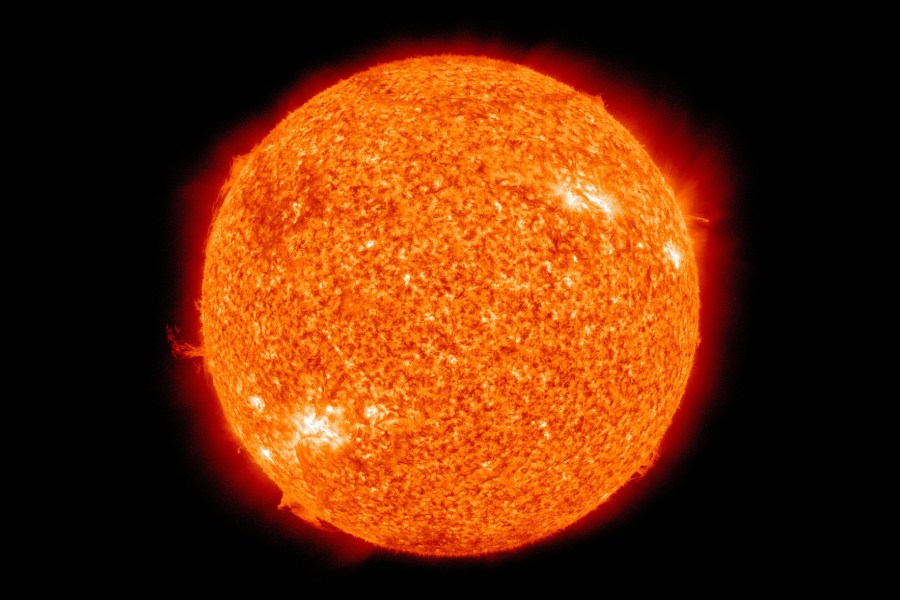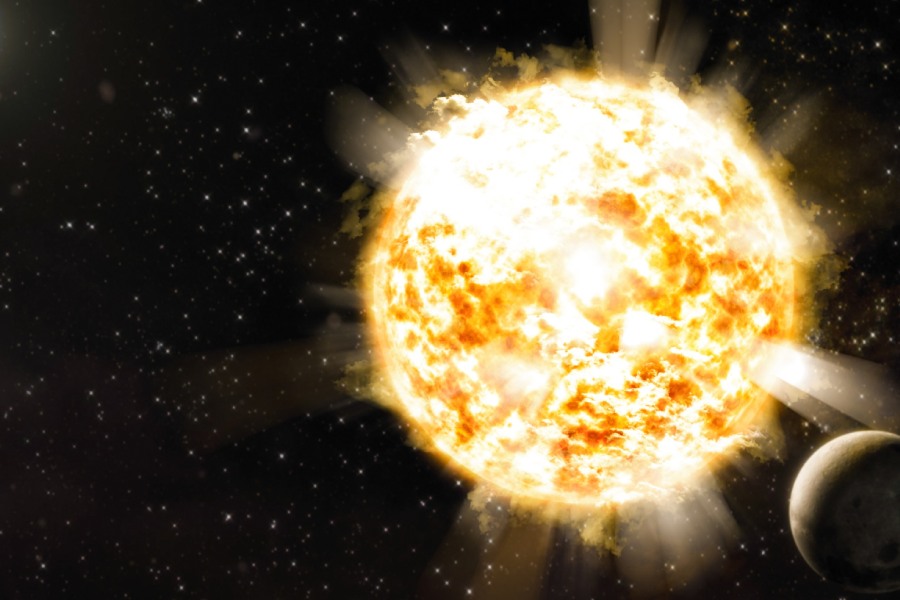The Sun brightens our days, yet its distant furnace makes directly studying its composition a persistent challenge that astrophysics helps unravel. Understanding what is the sun made of requires probing observations and models decoding its elemental gasses and charged plasma.
Modern science charts the particles within structural layers comprising our sun. This is achieved through signatures encoded in its light across space. Findings reveal the complexity below the familiar sun’s gleaming veneer regarding the cosmic origins and evolution of stars themselves.
Get ready to discover what modern astronomy teaches about the elements fused within the Sun’s core. Explore the churning magnetic fluxes in its roiling atmosphere. This exploration helps us truly examine what the sun is made of, shining light on our solar system and enhancing our understanding of our stellar parent in new ways.
What Is the Sun Made of?
The Sun is composed primarily of hydrogen gas. Approximately 74% of the Sun’s mass is hydrogen, which fuses into helium in the core, releasing enormous amounts of energy.
The next most abundant element is helium, at 24% of the total solar mass. Some original helium remains from the Sun’s formation, while hydrogen fusion continuously produces more within.
All other elements like carbon, nitrogen, and oxygen make up for the remaining 2% or so. But hydrogen and helium combined make up over 98% of the total mass that powers the Sun through nuclear fusion processes.

Sun’s Core Components
Why do we see the Sun as yellow, orange, or even red in color? Is the Sun made of fire? The answer is a definitive no! The Sun is made of a combination of gases.
Hydrogen makes up about 74% of the total solar mass, while helium constitutes about 24%. Hydrogen fusing into helium provides the foundation for the nuclear fusion process whereby mass is converted into energy.
Trace elements like carbon, oxygen, and neon comprise the remaining solar composition. These elements were part of the original solar nebula that eventually formed the Sun and planets.
Sun as a Vital Source of Energy
The nuclear fusion powering the Sun relies specifically on the dominant presence of hydrogen, which fuses into helium. This particular process releases enormous amounts of energy.
Without the heat and light generated by the Sun enabled by its composition, life on Earth would cease to exist. So, understanding these complex nuclear processes involving hydrogen and helium is key.
Anticipation for deeper exploration
Learning more about solar composition can better predict the activity cycles and energy fluctuations from the Sun that drive space weather, along with refining models for the lifecycle of stars.
Further explorations below the surface layers can reveal exciting insights into solar influences on Earth’s climate, atmosphere, and even technologies. There are still new discoveries to be made about our local star.
Introduction to Hydrogen as the Primary Building Block
Hydrogen exists in stars primarily as plasma, with one proton and one electron giving the simplest element and building block. The Sun contains an enormous quantity, over 90% of the mass, fueling nuclear fusion processes to shine bright across space.
Specifically, as we mentioned, hydrogen makes for more than half of the mass of the Sun, giving the essential ingredient for luminous energy output through fusion, without which mechanisms powering our star could not endure.
The incredible abundance of hydrogen allows perpetual fusion reactions, releasing heat and light from the core to span a solar life span measured over billions of years. Without such immense hydrogen quantities, chain reactions would fail, and our Sun could not reach the necessary luminosity.
The overwhelming dominance of hydrogen enables the Sun to attain stable fusion processes that produce brightness. This hydrogen abundance allows solar luminosity that streams outward continuously, illuminating and warming planets across our solar system.
Sustaining the Sun’s Luminosity Through Fusion
In the dense core, hydrogen fusion converts matter into energy, forming helium and releasing photons that give off tremendous radiant power according to E=mc^2. This constant nuclear fusion activity is vital for the Sun to release energy continually over billions of years.
If fusion halted, the Sun would cool and dim within only tens of millions of years, a blink relative to the lifetimes of stars. So this constant hydrogen ignition drives the solar luminosity that streams out from the core throughout the entire multi-billion-year lifespan so far, powering sunlight.
Heavier Elements
While hydrogen and helium dominate, heavier elements also occur within the Sun. Small amounts of iron, nickel, silicon, and oxygen exist alongside carbon and other atoms, present originally from the Sun’s formation days. There are still more discoveries to make regarding the Sun’s rich diversity of elemental makeup.
Many heavier elements originated distinct from the hydrogen-helium fusion process, developing through the primordial solar nebula instead. As research continues, the aim is to unravel the precise abundances at work in solar convective and radiative zones.
The heavier elements also influence the solar luminance and radiance seen from Earth, with spectral lines revealing their signatures. So they contribute texture and granular intricacy, complementing the Sun’s soulful aura of magic appreciated across civilizations for eons.

Chemical Elements
Exploration of various chemical elements in the Sun
The Sun consists of hydrogen, helium, and trace heavy metals like iron and nickel within its complex makeup. Studying signatures and emissions helps identify the elements and abundances within the star. Understanding the origins and representations of elements establishes insights into solar dynamics.
As technology advances, findings continue to provide revelations about the hidden chemical richness of the Sun. This allows us to refine models regarding nuclear fusion processes that generate sunlight. However, there’s still much more to uncover.
Interplay supporting the solar fusion engine
The detectable elemental fingerprints showcase the elaborate dynamics inside the Sun. While hydrogen and helium dominate, even trace quantities influence emerging theories about our star.
A delicate dance of particles, fields, and forces connects chemistry to emissions. Elements work together through nuclear fusion, modulating the energy flows and keeping our Sun bright for billions of years more.
Nuclear Fusion Reactions
Inside the core, hydrogen atoms fuse into helium – converting matter into energy. Just a slight portion of mass gets emitted as sunlight, streaming to Earth 150 million kilometers away.
Over 600 metric tons of hydrogen fuse each second. Binding energy from these transformative thermonuclear reactions supports the Sun’s luminosity for billions of years longer.
Unveiling the solar fusion mechanism
While the fusion engine remains obscured, neutrinos confirm our models by escaping the Sun intact. Detections further validate that nuclear fusion provides solar power.
Questions persist about our closest star. But breakthroughs show hydrogen supplies the fuel for fusion, enabled by the Sun’s intricate density layers that sustain our indispensable star.
Formation and Evolution of the Sun
The Sun formed about 4.6 billion years ago from a collapsing molecular cloud. Radioactive meteorites helped pinpoint this ancient timeframe for initial solar genesis. Although every research done until now has made history and changed how we see the Sun, there’s definitely much more left to uncover.
Understanding solar origins relies on studying early life cycles across similar stars. Additional clues come from particles originating from the proto-Sun that were trapped in space rocks within the Solar System.
Tracing the cosmic journey from birth to the present state
After the initial collapse, the baby Sun continued growing in mass until hitting stability with enough density to ignite fusion fires. These now sustain a solar lifespan measured over billions of years.
As nuclear processes convert core hydrogen into helium, gradual but lasting changes unfold inside the Sun that affect the energy flows keeping us warm. Projecting future solar evolution requires mapping models to actual measurable behaviors.
Exploring the evolutionary processes shaping the Sun
Complex sequences of proton-proton chains and carbon cycles generate the immense energy that flows up from the core to the solar surface. Tracking elemental migrations over long timescales informs projections for future states.
Validation from new exploration instruments will shape theories and simulations seeking to illuminate intricate long-term evolutionary mechanisms connecting origins to the present productive era of giving light to worlds.

Conclusion
By now, we hope you have a fuller picture of what is the Sun made of. This article illuminated that the Sun derives power from hydrogen gas fueling fusion. We also explored how heavier elements contribute to solar evolution over 4.6 billion years.
Inching closer through improved simulations and physics, we seek new discoveries about the chemistry and fusion dynamics of what constitutes the sun below the visible surface.
